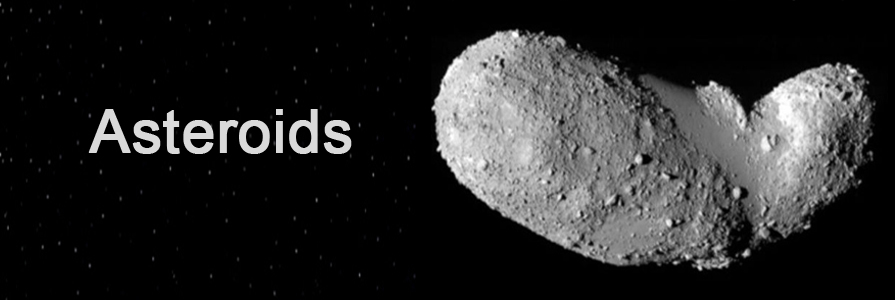
Asteroid Overview

Asteroids are rocky bodies that contain minerals and are at least three meters (10 feet) in size. However, the term asteroid has never been formally defined. Very large rocky bodies are also called planetoids or minor planets. The large asteroid in the banner above is Itokawa photographed by a Japanese spacecraft. It is about 2,000 feet long and about 800 feet wide.
There are millions of asteroids, many thought to be the shattered remnants of planetesimals, bodies within the solar system that never grew large enough to become planets. Planetesimal theory states that planets form out of cosmic dust grains that collide and stick together to form larger and larger bodies.
A large majority of asteroids orbit in the Asteroid Belt between the orbits of Mars and Jupiter. See the white area in the image to the left.
Individual asteroids are classified by their characteristic spectra, with the majority falling into three main groups: C-type, M-type, and S-type. These are found to be carbon rich, metallic, and silicate compositions.
Why does the Asteroid Belt exist? The main theory that astronomers suggest is that 4.6 billion years ago, when our solar system was forming, a planet tried to form between Mars and Jupiter. However, Jupiter’s gravitational force was too strong and the material was unable to coalesce and form a planet.
Even if a planet had formed, it would not have been anything to write home about. It is estimated that if you put all the asteroids in the Asteroid Belt together into one body, they would form an object that would be approximately 4% of our moon or 22% of Pluto.
The main difference between an asteroid and a comet is that a comet has an icy body with a coma and a tail as it passes the sun. An asteroid is mainly rocky material containing a few minerals. However, some asteroids do contain water, making the differences between an asteroid and a comet minimal. A further distinction is that comets typically have large eccentric orbits than do asteroids. Asteroids with eccentric orbits are most likely old comets whose water has been depleted. Top
Asteroid Discoveries

The first asteroid, Ceres, was discovered in 1801 by Giuseppe Piazzi, director of the Palermo Observatory in Sicily. See the photo of Ceres to the left taken by the Dawn spacecraft. Piazzi named it after Ceres, the Roman goddess of agriculture. It was originally considered to be a new planet. Note the two bright spots to the upper left of center.
In 2006, Ceres was promoted to the status of a dwarf planet. It did not reach full planetary status because it failed to gravitationally clear its neighborhood of debris. However, it still retains its classification as an asteroid too.
Until 1998, asteroids were discovered by a four-step process. First, a region of the sky was photographed by a wide-field telescope, or astrograph. Pairs of photographs were taken, typically one hour apart. Multiple pairs could be taken over a series of days. Second, the two films of the same region were viewed under a stereoscope. (a device for viewing a pair of images which depicts them as a single three dimensional image).
Any body in orbit around the Sun would move slightly between the films. Under the stereoscope, the image of the body would seem to float slightly above the background of stars. Third, once a moving body was identified, its location would be measured precisely using a digitizing microscope. The location would be measured relative to known star locations.
The last step of discovery is to send the locations and time of observations to the Minor Planet Center, where computer programs determine whether the sightings tie together into a single orbit. If so, the object receives a catalogue number and the first observer is declared the discoverer. The discoverer is then granted the honor of naming the object subject to the approval of the International Astronomical Union.
Since 1998 a group of eight very efficient survey projects, consisting of charge-coupled device cameras and computers, were directly connected to telescopes around the world. As of June 2016, over 14,400 near-earth asteroids have been identified. Near-earth objects (NEOs) also include more than one hundred near-earth comets. Top
More About Ceres
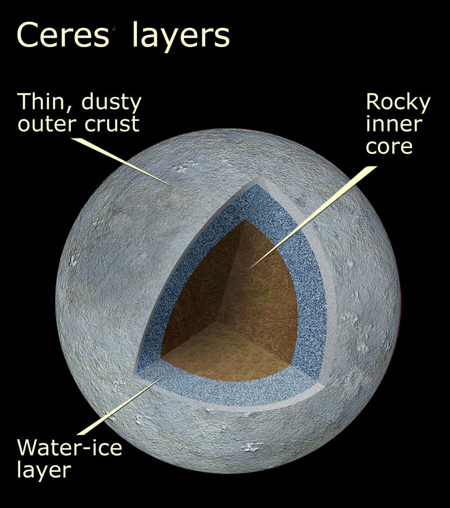
Ceres is a dwarf planet, the only one located in the inner part of the solar system; the others lie at the outer edges in the Kuiper Belt. The largest object in the asteroid belt, Ceres makes up nearly a third of its mass. Even so, it is the smallest known dwarf planet, roughly the size of Texas. A day on Ceres lasts a little over 9 earth-hours, while it takes 4.6 earth-years to travel around the sun.
In March 2015, NASA's Dawn spacecraft became the first probe to orbit two bodies in the solar system. After leaving the asteroid Vesta, Dawn traveled to Ceres, an icy world that has tantalized scientists. The two mysterious bright spots have stumped them for years. The Dawn spaceship will orbit around Ceres for the foreseeable future.
Ceres has a density of 2.1 grams per cubic centimeter, leading scientists to conclude approximately a quarter of its weight is water. This would give the dwarf planet more fresh water than earth. By comparison, earth has a density of 5.5 grams per cubic centimeter.
See the Ceres layer diagram to the left. Scientists think that water-ice serves as the mantle of the dwarf planet. The thin, dusty crust is thought to be composed of rock, while a rocky inner core lies at the center. In 2014, the European Space Agency's Herschel Space Observatory detected plumes of water vapor escaping from the dwarf planet at a rate of 13 pounds (6 kilograms) per second.
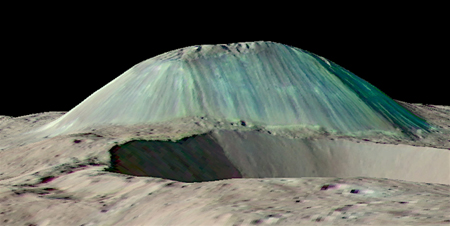
As the Dawn spaceship drew closer to the giant asteroid, the mysterious two bright spots on its surface grew clearer. After considerable observation of Ceres by Dawn, 130 spots of varying brightness were found on the planet. The bright spots ranged from the dull sheen of concrete to the startling brightness of ice floating on earth's oceans.
After a close up study of the spots, scientists think that they are made up of hydrated agnesium sulfates, the same material that makes up Epsom salt back on earth. Most of the bright regions are associated with craters, suggesting that their formation might be related to impacts from other space objects.
Ceres giant mountain dome, Ahuna Mons, rises above a foreground impact crater, pictured at the left above by NASA's Dawn spacecraft. Ahuna Mons is a volcano that rises 13,000 feet high and 11 miles wide at its base. Ahuna Mons is not made of lava the way volcanoes on earth are made - it's built from ice. "Ahuna is the one true "mountain" on Ceres," says David Williams, research professor at Arizona State University. "After studying it closely, we interpret it as a dome raised by cryovolcanism. Ahuna is truly unique, being the only mountain of its kind on Ceres," he said. "Ahuna is a volcanic dome built from repeated eruptions of freezing salty water."
The close proximity and low mass of Ceres have led some scientists to suggest that it could serve as a potential site for manned landings and a launching point for deep manned space missions. (See the section below regarding NASA mining asteroids.)
Near Earth Objects (NEOs)
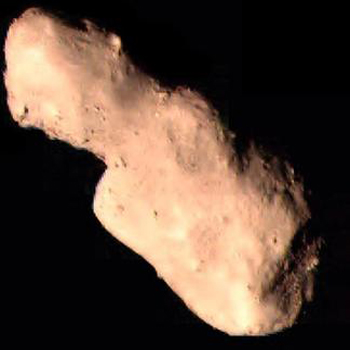
A Near-Earth Object (NEO) is formally defined as any small solar system body whose orbit partly lies within 1.3 astronomical units from the sun. See the Asteroid 4179 to the left, called Toutatis, which came within 2.3 lunar distances from the earth.
NEOs have become of increased interest because of increased awareness of the potential danger some of these asteroids and comets pose. In the United States, NASA has a congressional mandate to catalogue all NEOs that are at least 1 kilometer wide as the impact of such an object would be catastrophic. As of August 2016, there have been 873 NEOs larger than 1 km discovered, of which 157 are "potentially hazardous objects". It is estimated that about 70 remain to be discovered.
Potentially hazardous objects (PHOs) are currently defined as objects with an earth "minimum orbit intersection distance" (MOID) of 0.05 AU or less, and an "absolute magnitude" (a measure of the intrinsic brightness of a celestial object) of 22 or brighter (a rough indicator of size).
A 2016 NASA study indicated that a 100 meter diameter asteroid will cause localized casualties and damage across a few countries if it hit on either land or ocean. However, the consequences of a 200 meter diameter asteroid hitting the ocean increase significantly with tsunamis reaching a global scale. At 500 meters in diameter, almost any ocean impact will generate significant casualties and great economic costs across the world. Stephen Hawking has said "The general consensus is that any comet or asteroid greater than 20 kilometers in diameter that strikes the earth will result in the complete annihilation of all complex life, i.e. humans, animals and high level plants".
In January 2016, NASA announced the formation of the Planetary Defense Coordination Office to track NEOs larger than 30 meters in diameter and coordinate an effective mitigation effort. Top
New Study Looks At The Impact From Asteroids
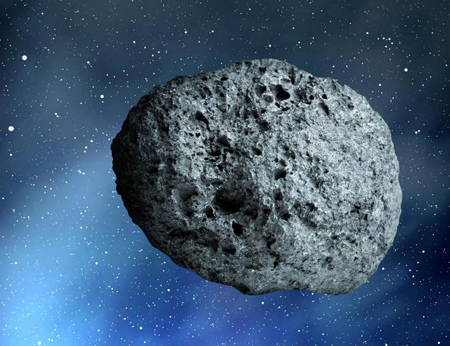
"This is the first study that looks at all seven impact effects generated by hazardous asteroids and estimates which are most severe in terms of human loss" said Clemens Rumpf, a senior research assistant at the University of Southampton in the United Kingdom, and lead author of a study published in the April, 2017 issue of Geophysical Research Letters.
The study explored seven effects associated with asteroid impacts: heat, pressure shock waves, flying debris, tsunamis, wind blasts, seismic shaking and cratering. Using computer models, the researchers estimated the lethality for varying sizes and then ranked the effects from most to least deadly, i.e. how many lives were lost to each effect.
The researchers modeled asteroids ranging from 15 to 400 meters (50 to 1300 feet) across - the diameter range of asteroids that most frequently strike the earth. Only asteroids that spanned at least 18 meters (nearly 60 feet) in diameter were lethal. Many asteroids on the lower end of the spectrum disintegrate in earth's atmosphere before reaching the planet's surface.
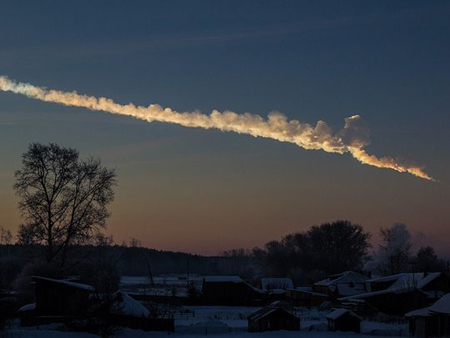
The meteor involved in the 2013 impact in Chelyabinsk, Russia (see the actual photo to the left), was about 20 meters (about 65 feet) across and caused more than 1,000 injuries. The majority of the injuries were caused by broken glass sent flying into the faces of locals peering through their windows after the meteor's bright flash.
Overall, wind blasts and shock waves were likely to claim the most casualties. In experimental scenarios, these two effects accounted for more than 60 percent of lives lost. Shock waves arise from a spike in atmospheric pressure and can rupture internal organs, while wind blasts carry enough power to hurl human bodies and flatten forests.
Land based impacts were on average an order of magnitude more dangerous than asteroids that landed in oceans. Large ocean impact asteroids could generate enough power to trigger a tsunami, but the wave's energy would likely dissipate as it traveled and eventually break up when it met a continental shelf. Heat generated by an asteroid accounted for nearly 30 percent of lives lost. Cratering and airborne debris were less dangerous, both garnering fewer than 1 percent of deaths. Seismic shaking was of least concern, as it accounted for only 0.2 percent of casualties.
Of course, an asteroid strike on Earth is quite rare. Rumpf says asteroids measuring 60 meters (about 200 feet) wide penetrate the atmosphere approximately once every 1500 years, while one measuring 400 meters (about 1,300 feet) across is likely to strike the planet every 100,000 years. Top
Asteroids By Size And Number
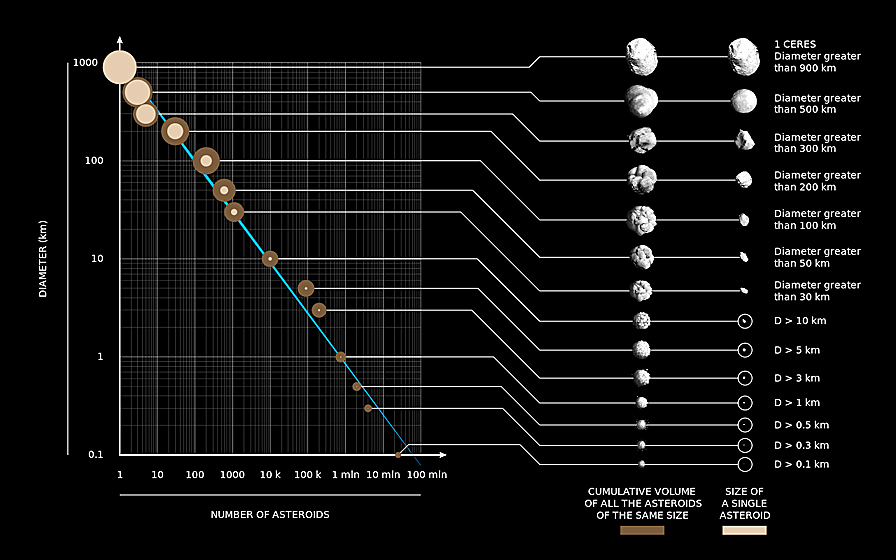
Asteroids vary greatly in size, from almost 1,000 kilometers for the largest down to rocks just 1 meter (3.3 feet) across. The four largest are very much like miniature planets. They are roughly spherical, have at least partly differentiated interiors and are thought to be surviving protoplanets. The vast majority, however, are much smaller and are irregularly shaped. They are thought to be either surviving planetesimals (bodies that never grew large enough to become planets) or fragments from collisions of larger bodies.
The dwarf planet Ceres is by far the largest asteroid, with a diameter of 950 kilometers (590 miles). The next largest are Vesta and Pallas, both with diameters of about 500 km (310 mi), and Hygiea with a diameter of 430 km (265 mi). (Approximately 6% of all meteors that have reached the earth have originated from Vesta.) About half the mass of the Asteroid Belt is contained in the four largest asteroids. When you get down to asteroids of one kilometer (3,280 ft.) in size, there are estimated to be about 750 thousand of them. At 100 meters (328 feet), there are estimated to be 25 million of them. As mentioned above, all the asteroids in the Asteroid Belt altogether would weigh in at about 4% of the weight of the moon. Top
The Cretaceous Extinction - Asteroid Theory
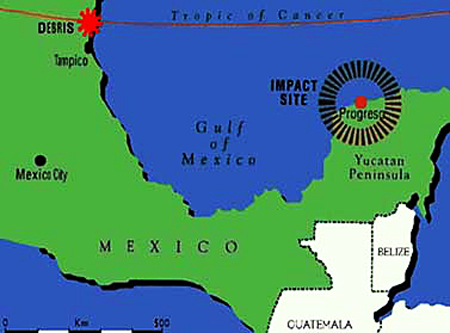
The Cretaceous Extinction occurred about 65 million years ago. Nearly all large vertebrates and many tropical invertebrates became extinct in what was clearly a climatic and biological event with worldwide consequences.
Since the early 1980s, the leading cause of the extinction has been the "Asteroid Theory" formulated by American scientists Walter and Luis Alvarez. This theory suggests that the impact of an asteroid probably triggered the extinction event by ejecting a huge quantity of rock debris into the atmosphere, enshrouding the earth in darkness for many months.
With no sunlight able to penetrate this global dust cloud, photosynthesis ceased, resulting in the death of green plants and the disruption of the food chain.
There is much evidence in the rock record that supports this hypothesis. A huge crater 180 km (112 miles) in diameter dating to the late Cretaceous has been discovered buried beneath sediments of the Yucatán Peninsula near Chicxulub, Mexico. See the impact site area in the map above.
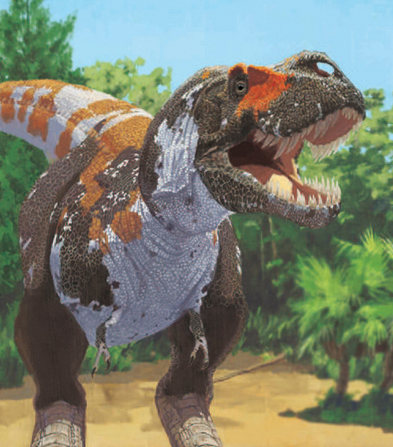
In addition, fractured sand grains characteristic of meteorite impacts and the rare-earth element iridium, common only deep within the earth’s mantle and in extraterrestrial rocks, have been found in deposits associated with the extinction. While there are several other theories floating about, most paleontologists believe the Asteroid Theory is the most likely cause of the extinction.
All dinosaurs, pterosaurs (flying reptiles), and ammonites (spiral-like shell fish) perished in the extinction event at the end of the Cretaceous Period. In fact, the land, seas, and skies were never the same. Of the planktonic marine flora and fauna, only about 13 percent of the species survived the extinction.
Ammonites (spiral-like shell fish) became extinct, as did marine reptiles. The marine organisms that lived on the bottom of the ocean largely died out and corals were reduced to about one-fifth of their species. Overall, approximately 80 percent of all animal species disappeared, making this one of the largest mass extinctions in earth’s history. Top
NASA - Kissing The Asteroid "Bennu"
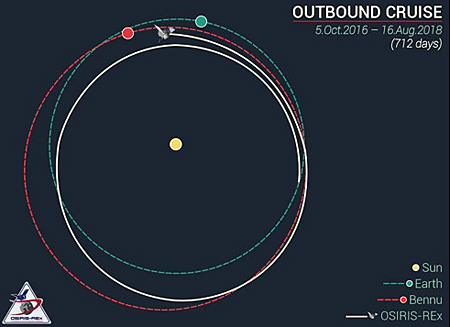
The Origins, Spectral Interpretation, Resource Identification, Security-Regolith Explorer (better known as OSIRIS-REx) spacecraft will travel a round trip of 4.4 billion miles in 7 years to visit a 510 meter (1,675 foot) diameter asteroid called Bennu. See the outbound orbits of OSIRIS-REx and Bennu to the left.
OSIRIS-REx will bring a material sample back to earth. The mission will help scientists investigate how planets formed, possibly how life began, as well as to improve our understanding of asteroids that could impact the earth.
The acronym OSIRIS was chosen in reference to the ancient Egyptian mythological god Osiris, the Lord Of The Dead. The name was chosen for this mission because asteroid Bennu is a near-earth-object possibly causing destruction and death in the late 2100s. (Based on current knowledge of its trajectory, Bennu has an estimated probability of about 0.07% of striking earth in the late 2100s.)
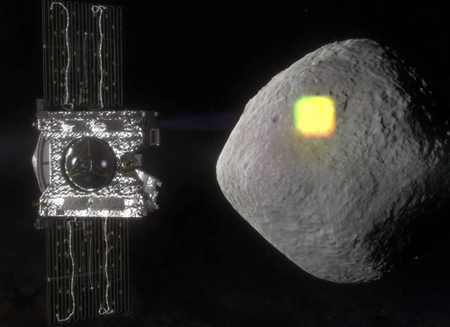
OSIRIS-Rex, successfully launched in September 2016, will be the first U.S. mission to sample an asteroid and return some of it back to earth for further study. After traveling for approximately two years, the spacecraft will rendezvous with asteroid Bennu in 2018 and begin 505 days of surface mapping at a distance of approximately 5 km (3.1 miles). See the artist's conception to the left of OSIRIS-REx developing a survey map of Bennu. Results of the mapping will be used by the mission team to select the site from which to take a sample of the asteroid's surface.
A very close approach (no landing) will be attempted to allow the extension of a 11 foot robotic arm to touch Bennu and gather the sample. See the artist's conception to the left below. Note the solar arrays raised into a 20 foot wide "Y-wing" configuration prior to arm contact to minimize the chance of dust accumulation.
The Touch-And-Go Sample Acquisition Mechanism (TAGSAM) is an elegantly simple sampler head. Once the sampler head makes contact with the surface of Bennu, a burst of pure nitrogen gas will cause rocks and surface material to be stirred up and captured in the sampler head. The TAGSAM sampler head will be in touch with the Bennu surface for a total of only 5 seconds. (Hence the "kissing" of the asteroid.) The spacecraft has enough nitrogen fuel to allow three sampling attempts in case the first two attempts should fail.
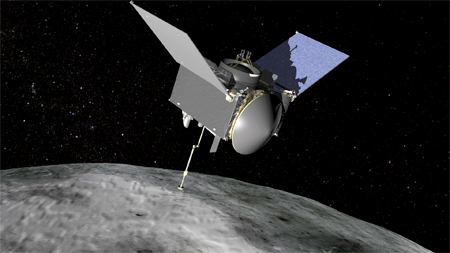
An asteroid was chosen as the target of study because an asteroid is a "time capsule" from the birth of our Solar System. In particular, Bennu was selected because of its availability of pristine carbonaceous material, a key element in organic molecules necessary for life as well as representative of matter from before the formation of the earth. Organic molecules, such as amino acids, have previously been found in meteorite and comet samples, indicating that some ingredients necessary for life can be naturally synthesized in outer space.
Following collection of the material (60 grams to 2 kilograms) in July 2020, the sample will be returned to earth in a capsule. The return trip to earth will land at the Utah Test And Training Range in September 2023. The capsule will then be transported to the Johnson Space Center for processing in a dedicated research facility.
The mission was developed by the University of Arizona's Lunar and Planetary Laboratory, NASA Goddard Space Flight Center and Lockheed Martin Space Systems. The Principal Investigator is Dante Lauretta from the University of Arizona. The cost of the mission including the rocket takeoff will be approximately one billion US dollars. Much more information on the NASA OSIRIS-REx mission is available here. Top
NASA Wants To Mine Asteroids
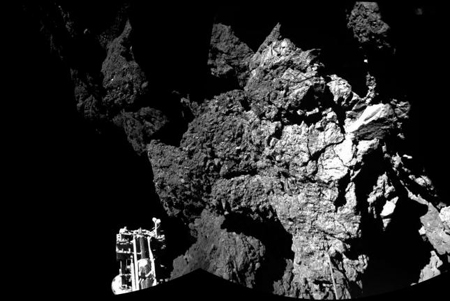
In the wake of the November 2014 European Space Agency's successful Philae landing on Comet 67P/C-G (see the photo to the left), NASA is also planning to land on and mine asteroids. NASA has contracted two private space firms, Deep Space Industries and Planetary Resources, to prepare for and ultimately execute missions to land on and mine asteroids for valuable resources.
Although these expeditions could theoretically return to earth with valuable minerals, the financial viability of the concept relies on the prospects of supplying other space missions with assets. If asteroid mining is successful, NASA, with many deep space missions planned in the coming century, would be able to save a lot of time and money.
NASA would benefit by supplying some of those missions (including International Space Station expeditions) with space-stored vital resources such as water and carbon minerals. Water, oxygen, nitrogen, and other materials with low boiling points are hard to come by in space, and are necessary for future space exploration. Water in particular is expensive because it is incompressible and heavy.
The fuel it takes to rocket out of the earth's gravity makes launching anything into space exceptionally expensive. By contrast, asteroids have minuscule centers of gravity, making coming and going from them inexpensive. "Right now it costs $17 million per ton to get anything up in orbit," David Gump, vice chairman of Deep Space, told The Boston Globe. "If we can beat the price in 2022, we'll have a big market." Despite sounding like a science-fiction novel, the physics of asteroid mining are not overwhelming. There is a lot of engineering to be done, but many experts believe it is indeed possible.